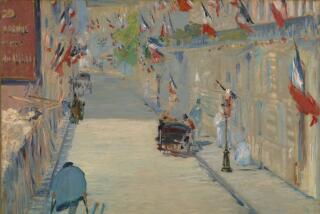Keeping His Aye on the Big Picture
- Share via
Robert Rahway Zakanitch is a burly guy, but he appears dwarfed by his own 11-by-30-foot paintings at the Patricia Faure Gallery. The “Big Bungalow Suite,” as he calls his latest work, is his answer to the stubbornly recurrent question in late 20th century art: “Is painting dead?”
As Zakanitch stands next to his painted tapestry of giant hibiscus, tendrils and silkworms, his shaggy white eyebrows shoot up when he says, “It seems like this whole century has been a conspiracy to eliminate beauty. The last 25 years have been about the idea in art. How puritanical can it get?”
Zakanitch’s paintings are so massive that they had to be shown in two locations. In addition to the two panels and large watercolors at the Faure Gallery in Santa Monica, on view Saturday to Oct. 18, three panels are on view at the Ruth Chandler Williamson Gallery at Scripps College in Claremont through Oct. 19. When they were exhibited three years ago at Jason McCoy Galley in New York, art critic Brooks Adams described them in the show’s catalog as causing “a giddiness that touches on the sublime.”
Zakanitch, now 62, came to the attention of critics in the mid-’70s as a founding member of the so-called Pattern and Decoration movement. The artist is quick to point out that there was never a cohesive point of view among the artists associated with the group, such as Robert Kushner, Kim McConnell and Joyce Kozloff. Yet all were reacting to the dominance of Conceptual art and the oft-heard opinion that painting was dead.
“Art became removed from physicality and sensuality when Conceptualism reached its peak in the early ‘70s,” he says. Twenty years later, Neo-Conceptualism, often made by students of first- and second-generation Conceptual artists, dominates international exhibitions from New York to Kassel, Germany. In the face of it, Zakanitch decided it was time, once again, to take a stand for painting and for beauty.
Visiting Los Angeles from his studio in Brooklyn, N.Y., Zakanitch explains his motives: “I’m tired of all these awful artists telling me that painting is dead. They don’t know what painting is. These people come out of art colleges, schooled in Minimalism, formalism and Conceptualism, and know nothing about serious painting. It’s foreign to them. How can you expect them to have any other opinion when their brains are full of ideology?”
In Zakanitch’s recent pictures, the tumult of wallpaper flowers is drawn from memories of his childhood in New Jersey. A few years ago, he adopted the name of his hometown of Rahway as his middle name to acknowledge his working-class roots.
“It was time to embrace rather than reject my past. When you realize that none of your demons can hurt you anymore, you embrace your life as a whole,” he explains.
Zakanitch, the youngest of three boys, escaped his drab home life by spending time at his grandmother’s house. She had embroidered the towels and tablecloths. Drapes and slipcovers were flowered, as was the linoleum floor. Zakanitch spent much of his childhood drawing and painting in her basement.
“It kind of saved my life--the power and beauty of creativity,” he says. “I could not have done those ‘Big Bungalow Suite’ paintings if it weren’t for those years at my grandmother’s. The subject matter lends itself to a feeling of joy, celebration and buoyant energy.”
Arthur Danto, writing in the Nation, observed that the “Big Bungalow” panels “are a masculine tribute to feminine values, a salute across the boundaries of gender and of generation and of class to what made the artist what he is.”
Education was not a priority in the artist’s family. His father, a first-generation Ukrainian, and his mother, who was born in Czechoslovakia, had attended school only up to the fifth grade. After high school, Zakanitch worked for a year driving a forklift to pay for his tuition at the Newark School of Fine and Industrial Arts. His three years there were “magic,” he recalls:
“I suddenly realized there were books, movies, art, music and ideas. It was like art somehow opened up my entire world. It went against my lower-class background, where there was no idea about aesthetics.”
After graduating in 1956, he was hired to do paste-up at an advertising agency in Manhattan. Two years later, he was placed in the special services division of the Army at Ft. Knox in Kentucky. When discharged, he went back to New York and worked for D’Arcy Advertising. A friend took Zakanitch to the Sydney Janis Gallery in 1960, where he saw a show of paintings by Willem de Kooning, Franz Kline and Mark Rothko.
“I thought the Abstract Expressionist paintings were gorgeous,” he says. Two years later, at 27, he was devoting himself to such painting and supporting himself with part-time jobs in advertising. He began working in the Abstract Expressionist style. “I tell students not to be afraid, because you are only influenced by what you like. I loved De Kooning, so there was something there that was mine. Eventually, you grow into yourself.”
Yet it took a nervous breakdown and time in analysis before Zakanitch grew into himself. In the late ‘60s and early ‘70s, his formalism followed the dictates of strict Modernist critic Clement Greenberg about the purity of materials, about surface, shape and color.
“I was doing marks, but they kept coming out as patterns,” Zakanitch says. “I thought I had to keep them abstract because that is how I had been schooled. I loved patterns and Oriental rugs, but I thought, ‘How does this relate to art?’ There were no theories about this kind of work. It was like finding a new color.”
In 1974, Zakanitch was a visiting artist at UC San Diego when he met McConnell, whose paintings at that time recalled Asian textiles. In January 1975, he invited to his New York studio artists like Kozloff and Kushner, who were working with images of pattern and decoration, attempting to find their way out of the cul-de-sac of formalism.
Zakanitch sought ideas from rug shops and from hardware stores, which had wallpaper books and linoleum samples. He began using stencils. At the Holly Solomon Gallery, in 1975, he showed a 6-by-18-foot triptych called “For Louis Sullivan,” which featured a floral center and curlicue leaves and branches on the sides.
“I took all the schooling from formalism and Abstract Expressionism--the scale, surface and color--and portrayed imagery that was anathema to that purity of thinking,” he says. “These were very aggressive paintings of cherries, red peppers and flowers.
“The avant-garde idea is that you must destroy everything around you. That idea to me was so primitive, and I thought the notion of an avant-garde was very passe. I wanted to include all of it, to pay homage to where I’d been but bring in all this new information.”
The issues raised by Pattern and Decoration--avoiding either abstraction or representation; transgressing boundaries traditionally defined by gender--have served to inspire a younger generation of painters including Lari Pittman, Phillip Taaffe, Mary Beyt and Renee Petropoulos.
Elements of kitsch and pop culture appeared in his earliest pictures, but Zakanitch, despite his advertising background, never related to Pop art: “After awhile irony becomes boring. My paintings were more domestic and personalized. I wanted the work to have an intimate quality.
“In the ‘60s, there was this whole thing about artists not wanting the audience to get it. I always want my audience to get it. They don’t have to understand it, but when they see it, I want them to go, ‘Aah.’ That’s some sort of class thing, to be too cool and sophisticated to be moved by beauty.
“I think art is about allure,” he adds. “My paintings have an in-your-face sentimentality, another word that has become negative. But sentimentality, for the most part, is humanizing, a state of deep caring. I don’t see how you could negate that. Is sticking a knife in someone more interesting?
“When I started painting, I would always take out anything that was about sweetness,” he says. “I wanted those paintings to be tough and strong. But toughness is a facade to cover up fear. It took me a long time to realize that the most difficult thing to do is to make a sweet, pretty painting. That is truly tough.”
*
ROBERT RAHWAY ZAKANITCH, Patricia Faure Gallery, 2525 Michigan Ave., B-7, Santa Monica. Dates: Opens Saturday. Tuesdays to Saturdays, 10 a.m. to 5:30 p.m. Ends Oct. 18. Phone: (310) 449-1479. Also: Ruth Chandler Williamson Gallery at Scripps College, 11th and Columbia streets, Claremont. Through Oct. 19. (909) 607-3517.
More to Read
The biggest entertainment stories
Get our big stories about Hollywood, film, television, music, arts, culture and more right in your inbox as soon as they publish.
You may occasionally receive promotional content from the Los Angeles Times.










